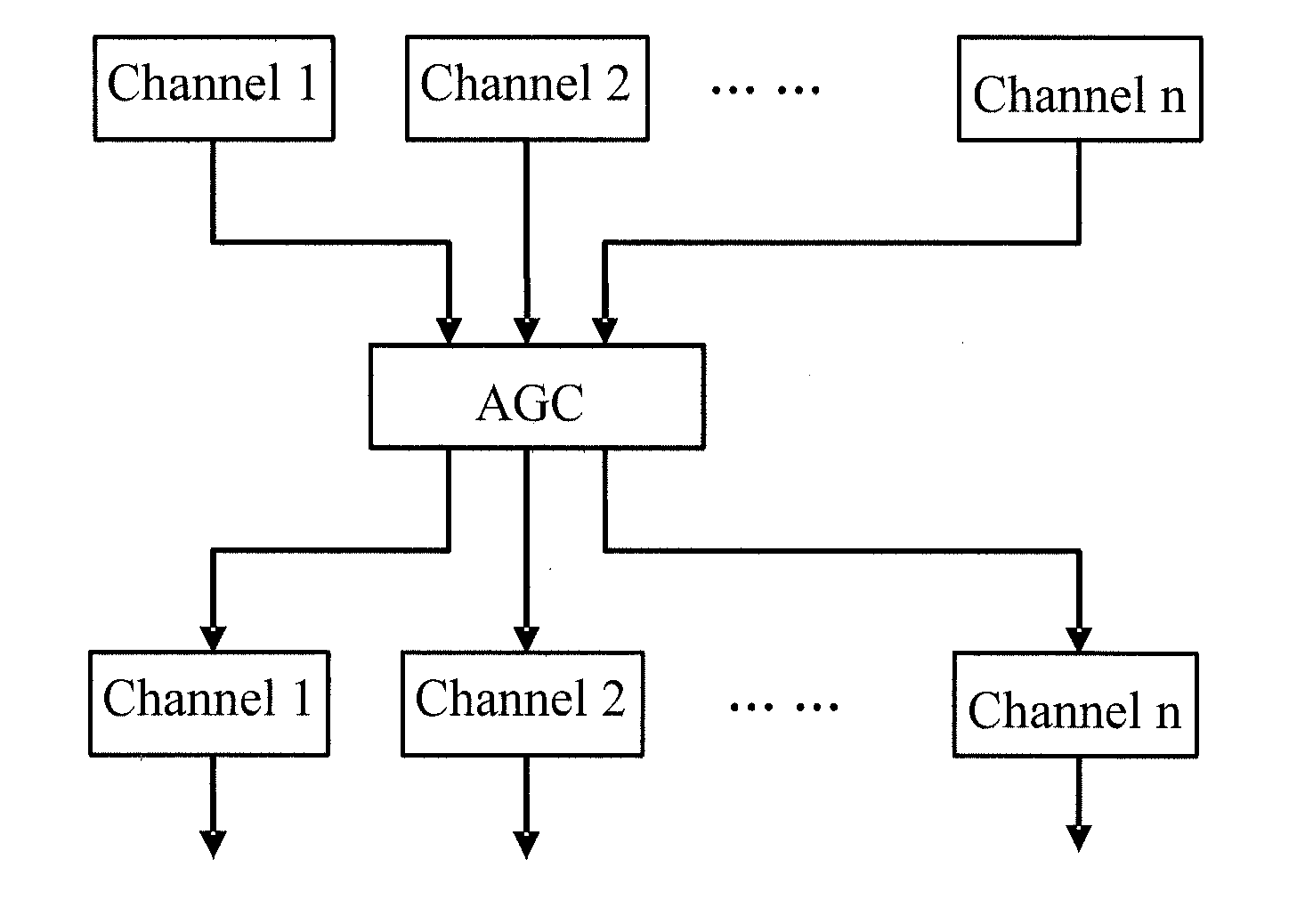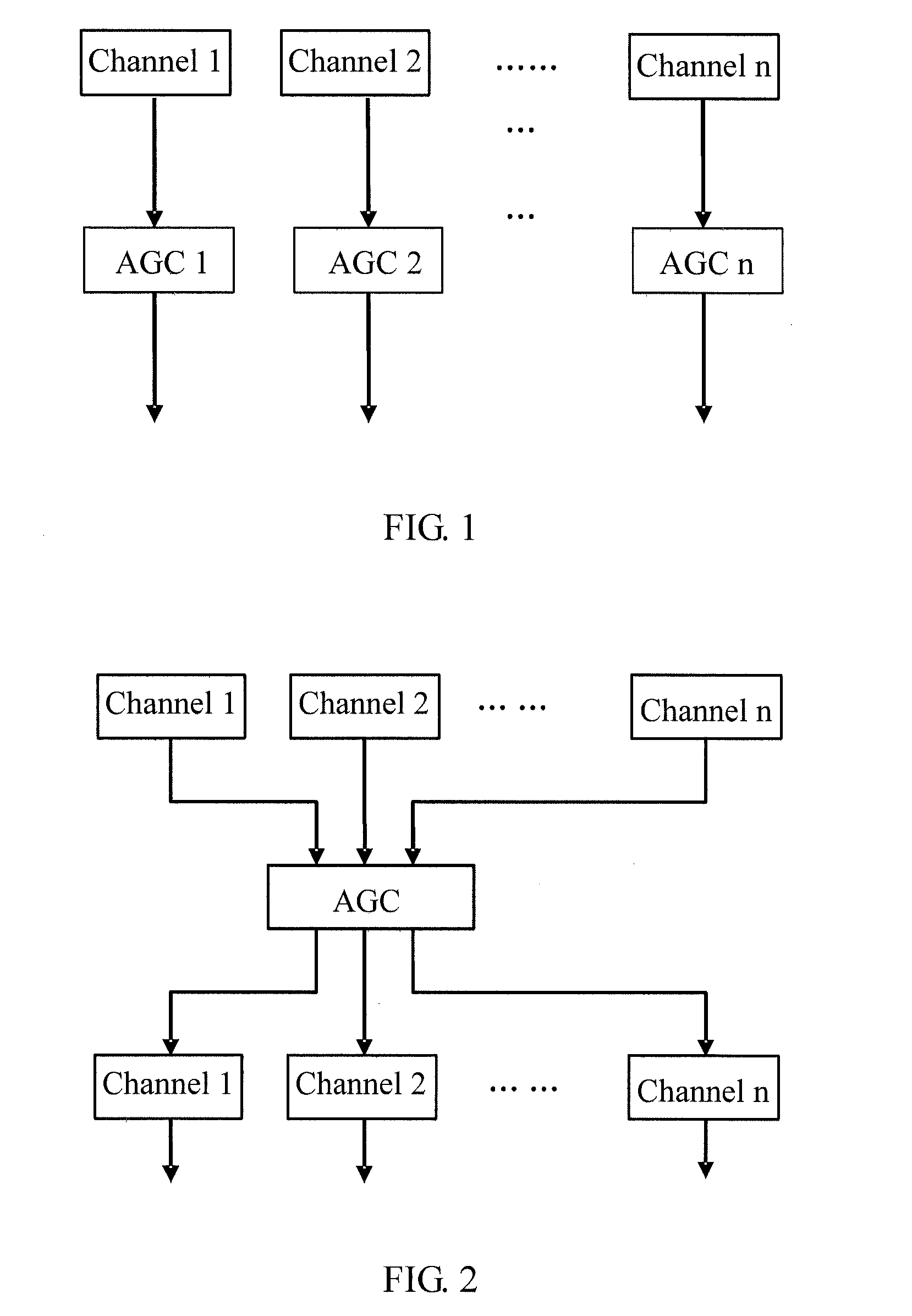Method and apparatus for controlling gain in multi-audio channel system, and voice processing system
a multi-audio channel and gain control technology, applied in the field of communication technologies and signal processing technologies, can solve the problems of destroying the original stereo sound, destroying the perception of the sound location and orientation sense of the original sound, and unable to process different audio channels by the same agc uni
- Summary
- Abstract
- Description
- Claims
- Application Information
AI Technical Summary
Benefits of technology
Problems solved by technology
Method used
Image
Examples
embodiment 1
[0055]In this embodiment, it is assumed that the gain control is performed in a dual-audio channel system.
[0056]As shown in FIG. 4, in a dual-audio channel scenario, similarity or correlation of sound between the two audio channels is judged first. If the similarity or correlation between signals on the two audio channels reaches a preset threshold, the two audio channels are sorted by the grouping module into the same group. A control switch inputs signals on audio channels in the same group into the same AGC unit (namely, AGC 1 in the figure), and the gain of such signals on audio channels is processed and controlled by the same AGC unit (namely, AGC 1). If the two audio channels are not similar, the grouping module sorts them into two different groups, and each group is processed by a different AGC unit. That is, audio channel 1 is processed by AGC 1, and audio channel 2 is processed by AGC 2.
[0057]For example, if only one person is speaking, because the sound source is the same,...
embodiment 2
[0061]In a multi-audio channel application scenario, assuming that the number of audio channels is n (n>2), similarity or correlation of sound between the audio channels is judged first. The judgment method is similar to the dual-audio channel scenario in Embodiment 1. Similar or correlated audio channels are sorted into one group. If k (k1, which is processed by the same AGC unit; if L (L2, which is processed by the same AGC unit. Other similar or correlated audio channels are grouped in the same way. For example, there are m (2<m≦n) groups in total, which are processed by m AGC units respectively.
[0062]As shown in FIG. 6, a 6-audio channel communication system is described below as an example.
[0063]First, 6 AGC units are created, and each audio channel is bound to an AGC unit. Audio channel 1 is bound to AGC 1, audio channel 2 is bound to AGC 2, and so on. As shown in FIG. 6, audio channel 1, audio channel 2, and audio channel 3 form one group if they are correlated; audio channel...
embodiment 3
[0065]In this embodiment, if the correlation between the 6 audio channels in Embodiment 2 changes, the 6 audio channels are regrouped by the grouping unit. For example, as shown in FIG. 7, after the correlation changes, none of audio channel 1, audio channel 2, and audio channel 3 is similar or correlated to other audio channels, but audio channel 4, audio channel 5, and audio channel 6 are correlated. Therefore, the grouping unit puts them into four groups: audio channel 1, audio channel 2, and audio channel 3 form three different groups, and audio channel 4, audio channel 5, and audio channel 6 form one group.
[0066]Audio channel 1, audio channel 2, and audio channel 3 are processed by AGC 1, AGC 2, and AGC 3 respectively, but audio channel 4, audio channel 5, and audio channel 6 are processed by AGC 4 uniformly. The state information of AGC 4 is synchronized to AGC 5 and AGC 6. The state information includes gain adjustment parameters such as envelope energy value of a previous fr...
PUM
 Login to View More
Login to View More Abstract
Description
Claims
Application Information
 Login to View More
Login to View More - R&D
- Intellectual Property
- Life Sciences
- Materials
- Tech Scout
- Unparalleled Data Quality
- Higher Quality Content
- 60% Fewer Hallucinations
Browse by: Latest US Patents, China's latest patents, Technical Efficacy Thesaurus, Application Domain, Technology Topic, Popular Technical Reports.
© 2025 PatSnap. All rights reserved.Legal|Privacy policy|Modern Slavery Act Transparency Statement|Sitemap|About US| Contact US: help@patsnap.com



